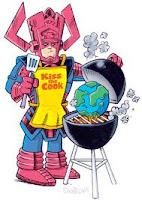Last week, Cartoon Network premiered its first original CGI animated movie, Firebreather. This CGI flick is based on a short-lived comic book series of the same name, created by Phil Hester and Andy Kuhn and published by Image Comics, and it was directed by none other than Peter Chung, the creator of the fantastically bizarre Aeon Flux
I saw Firebreather the other day and it's mostly a blend of Buffy The Vampire Slayer, X-Men and Godzilla--but that's not a necessarily bad thing. What Firebreather lacks in originality it more than makes up for in impressive animation, well choreographed action scenes, solid voice casting, and impressive monster designs. For me, the most interesting detail of the Firebreather story is that it takes place in a world where giant monsters are a common threat and that these monsters are explicitly referred to as "kaiju". Even though Japanese kaiju movies and their associated merchandise have been arriving in the U.S. since the 1950s, this is the first time that I've ever seen an American cartoon directly refer to giant monsters as kaiju. Heck, Godzilla--the king of the kaiju himself--had two different animated series here in the U.S., and neither of them used the word "kaiju" at all.
Watching such open fan appreciation of the kaiju subgenre of monster movies in the Firebreather cartoon made me think back to another American cartoon back in the 1980s that could also have used the word kaiju to great effect but didn't: Inhumanoids. Read on for more about this missed kaiju opportunity and why it deserves to be awakened from its deep pop culture slumber for modern monster fans.
Like many cartoons of the 80s, Inhumanoids was a combination of a toy line and an animated series to help promote the toy line. Inhumanoids did not become a hit like other toy line/cartoon titles of the 80s such as He-Man, Transformers and G.I. Joe; in fact, the toy line folded quickly and its cartoon only lasted for 13 episodes which aired in the Fall of 1986. However, what made Inhumanoids very unique in comparison to its counterparts is that it was the first horror cartoon ever to air on U.S. television. It was also the first example (as far as I can remember) of a toy line that was devoted to completely new monsters, not a toy line based on movie monsters such as classic Universal Studios monsters or Alien.
Inhumanoids was about the Earth Corps, a group of heroes who bore a passing similarity to the title characters featured in The Challengers of the Unknown
Overall, the cartoon's quality of animation and writing weren't that good and it often veered wildly between morbid horror, clunky melodrama, and outright camp. For example, in an episode entitled "Primal Passions", one of the monsters falls madly in love with the Statue of Liberty(!) after being exposed to an unknown substance. Yet whatever its shortcomings, Inhumanoids used its kaiju villains as a means to bring various horror-oriented subjects--subjects such as dismemberment, ancient cults, demonic possession, and corpses in varying states of decay and reanimation--to an otherwise horror-free area of entertainment: syndicated cartoons.
Embodying most of Inhumanoid's horrific aspects were two of its main kaiju, Tendril and D.Compose. As his name suggests, Tendril is a lumbering mass of vine-like limbs that can change size and regenerate. If big enough, pieces of Tendril's dismembered limbs can grow into new Tendril monsters.
The toy version of Tendril
D.Compose is a talking zombie dinosaur (that's right: a talking zombie dinosaur!) that hates exposure to sunlight and can immobilize his human enemies by placing them in his exposed, rotting rib cage. (Even the toy version of D.Compose had this feature--yummy!)
The toy version of D.Compose
But that's not all: D.Compose can turn others into giant, undead monstrosities just by touching them and loudly screeching "Decompose!" In an early episode of the series, D.Compose grabs one of the Earth Corps heroes, works his monster mojo on her, and just seconds later--before you can say "Oh no he didn't!"--she turns into an enormous screaming skeletal corpse that sort of resembles a Deadite from the Evil Dead movies, and then the episode ends. (I saw this episode when it first aired and I was shocked--back then, cartoons just weren't supposed to do this. Even Robotech, which had a very high body count that included both secondary and main characters, didn't do the kind of explicitly scary stuff that Inhumanoids did.) In another episode, D.Compose uses his power of decay to unleash an army of teenage zombies into the streets of San Francisco and two other Earth Corps heroes are zombified in the process; this was ten years before the first Resident Evil
With all of the recent revivals of 80s era toy line/cartoon titles, such as the re-launch of the He-Man toys and the production of big-budget, live-action movies for Transformers and G.I. Joe, I'm baffled that no one--not even McFarlane Toys or NECA--has given Inhumanoids another chance to traumatize a new generation of cartoon-watching, toy-craving youngsters. This is one series of monsters that definitely deserves to be brought back from the dead.
Rhino released Inhumanoids DVDs a few years ago, and YouTube has video clips of Inhumanoids cartoons and toy commercials. You can also check out the Wikipedia page on Inhumanoids to learn more about this short-lived series.
Above are customized Inhumanoids action figures
(pictures courtesy of Figure Realm).































